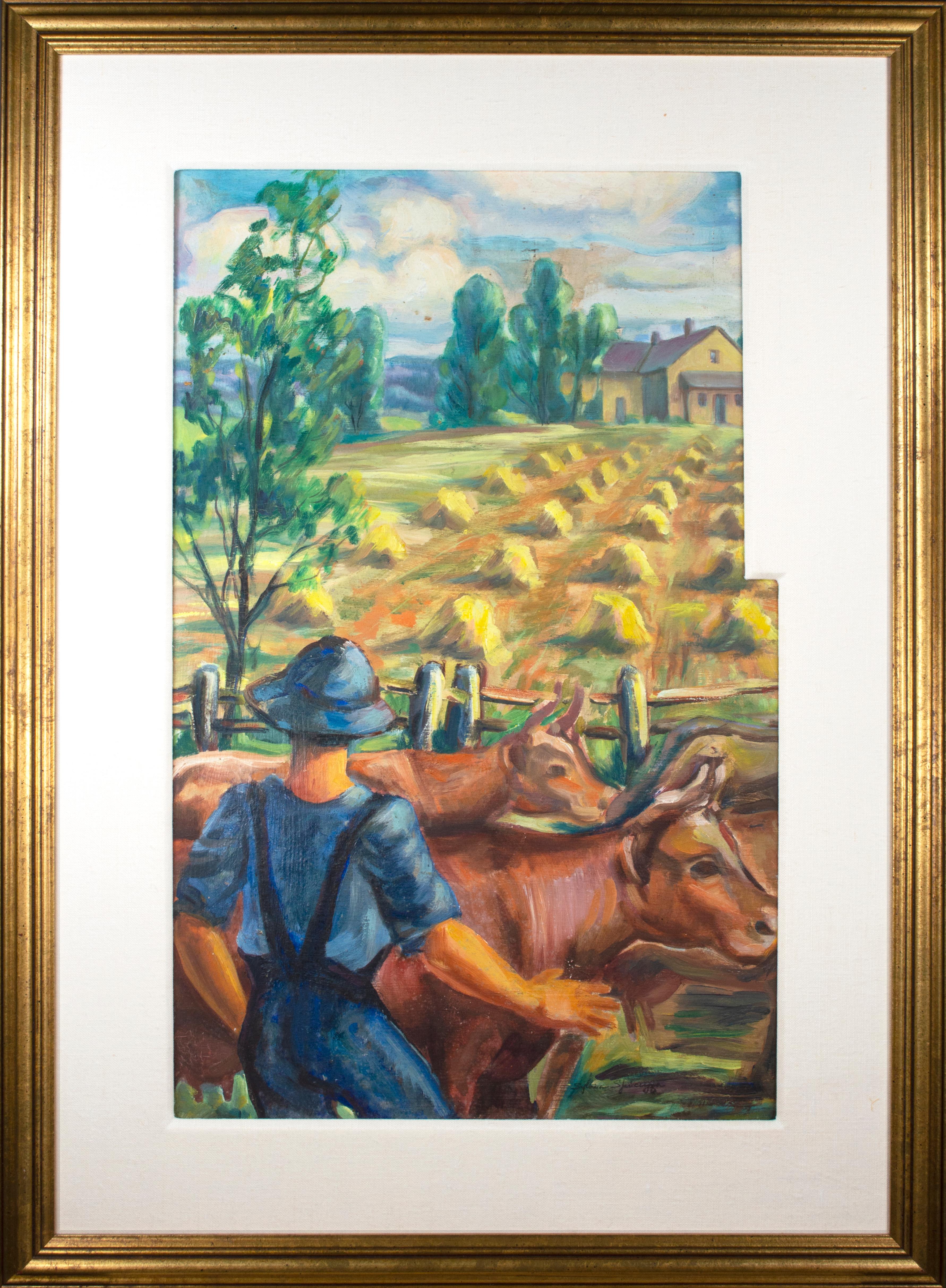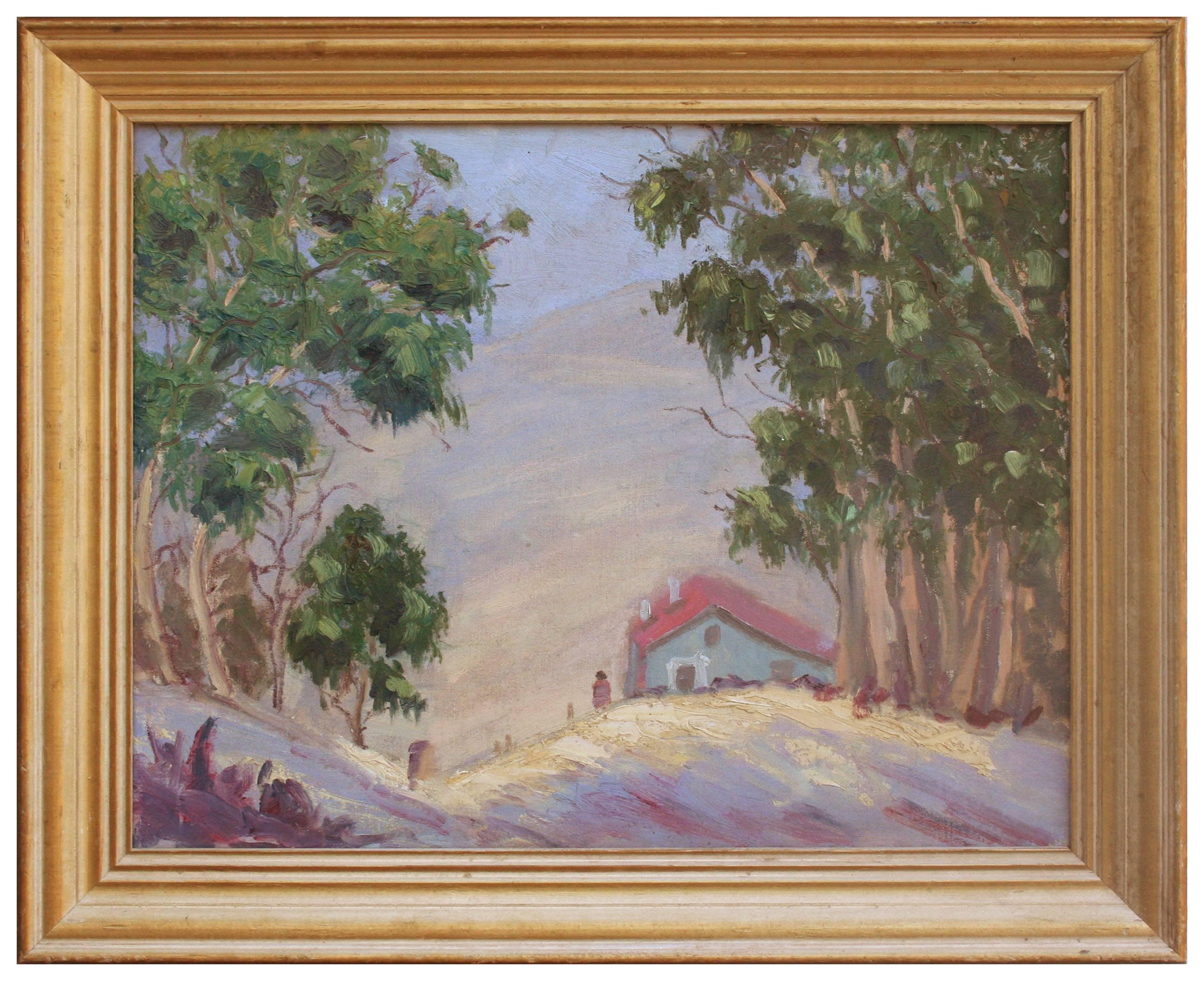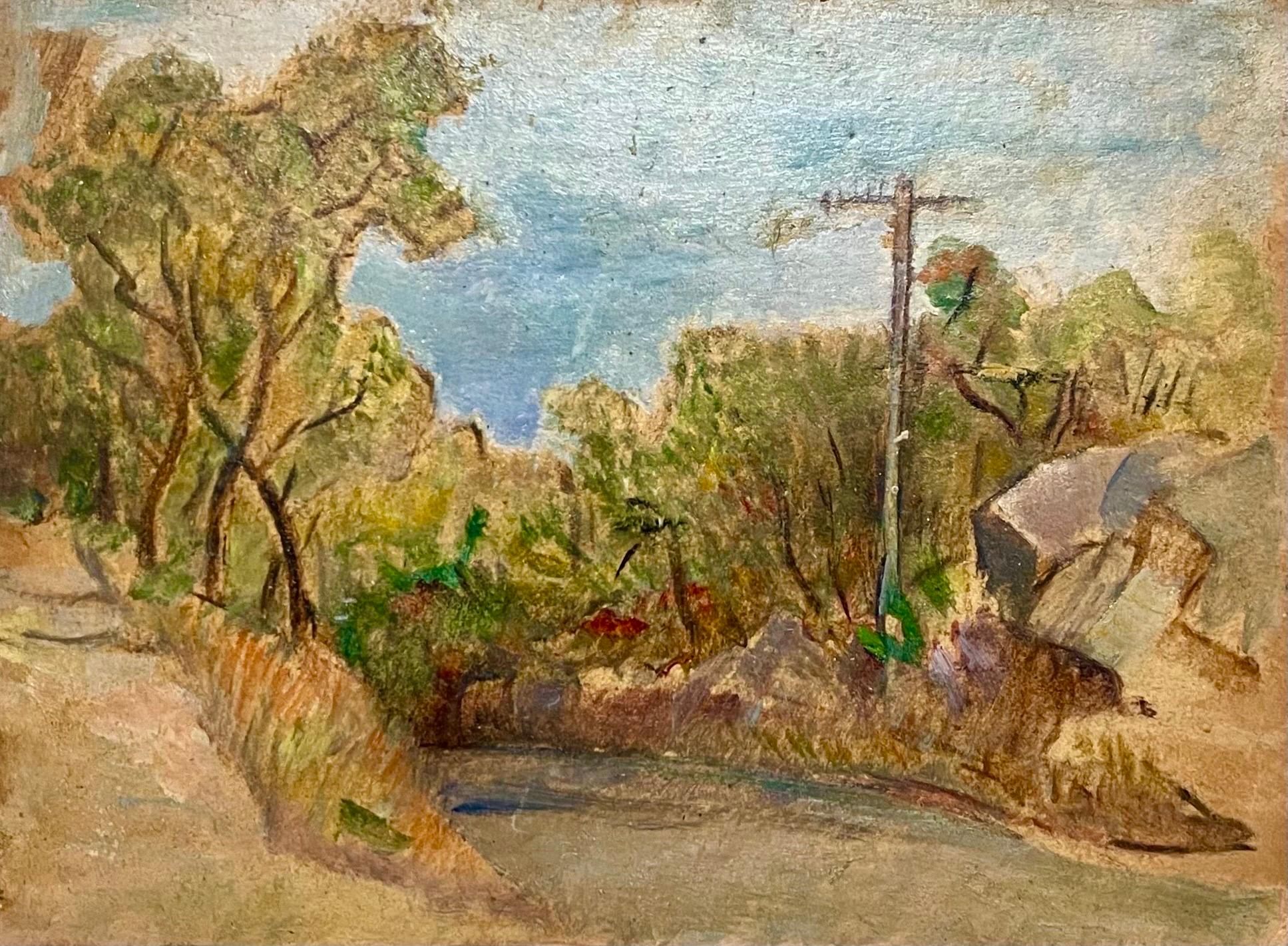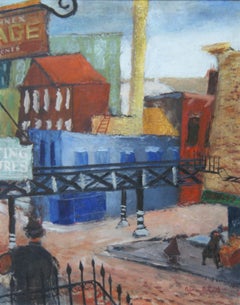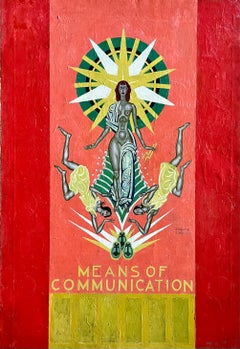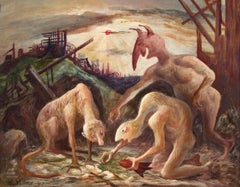Items Similar to "6th Avenue El" American Scene Social Realism Mid-20th Century New York City
Want more images or videos?
Request additional images or videos from the seller
1 of 8
Ernest Fiene"6th Avenue El" American Scene Social Realism Mid-20th Century New York Cityc. 1940
c. 1940
About the Item
"6th Avenue El" American Scene Social Realism Mid-20th Century New York City
Ernest Fiene (1894-1965)
"6th Avenue El"
12 1/4 x 14 1/4
Oil on canvas board, c. 1940s
Signed lower right
Framed 20 x 22 inches
BIO
Fiene, born in Germany, became a naturalized citizen of the United States in 1927, having spent the previous fifteen years studying art at various New York institutions and building his reputation as a painter of American scenes.
A fixture on the faculty of the Art Students League, he was also a prolific artist with a body of work spanning many media, from etchings to frescoes.
----------------------------------------------------------------------
A teacher and artist, Ernest Fiene created works in many media but was noted primarily for his landscapes of American scenes. He also did portraits, etchings, lithographs, murals and book illustrations. Unlike many of his contemporaries, he refused to isolate technique from subject matter, and incorporated his interest in human life and his optimism about humanity into his paintings.
He was born in Elberfeld, Germany, came to the United States in 1912, and was naturalized by 1927. He studied at the National Academy of Design from 1914 to 1918, at the Beaux-Arts Institute of Design from 1916 to 1918, and was also at the Art Students League and in Paris at the Academie de la Grande Chaumiere.
From 1938 to 1964, he taught at the Art Students League and was also a member of the supervising faculty of the Famous Artists School in Westbury, Connecticut.
- Creator:Ernest Fiene (1894-1965, American)
- Creation Year:c. 1940
- Dimensions:Height: 20 in (50.8 cm)Width: 22 in (55.88 cm)
- Medium:
- Movement & Style:
- Period:
- Condition:
- Gallery Location:New York, NY
- Reference Number:1stDibs: LU1156215681172
About the Seller
5.0
Platinum Seller
Premium sellers with a 4.7+ rating and 24-hour response times
Established in 2008
1stDibs seller since 2019
189 sales on 1stDibs
Typical response time: <1 hour
- ShippingRetrieving quote...Shipping from: New York, NY
- Return Policy
Authenticity Guarantee
In the unlikely event there’s an issue with an item’s authenticity, contact us within 1 year for a full refund. DetailsMoney-Back Guarantee
If your item is not as described, is damaged in transit, or does not arrive, contact us within 7 days for a full refund. Details24-Hour Cancellation
You have a 24-hour grace period in which to reconsider your purchase, with no questions asked.Vetted Professional Sellers
Our world-class sellers must adhere to strict standards for service and quality, maintaining the integrity of our listings.Price-Match Guarantee
If you find that a seller listed the same item for a lower price elsewhere, we’ll match it.Trusted Global Delivery
Our best-in-class carrier network provides specialized shipping options worldwide, including custom delivery.More From This Seller
View All"Money Lender" WPA American Scene Social Realism Modern Mid 20th Century
By Mervin Jules
Located in New York, NY
"Money Lender" WPA American Scene Social Realism Modernism Mid Century
Mervin M Jules (1912-1994
"The Money Lender"
15 1/2 x 20 1/2 inches
Oil on board, c. 1940s
Signed lower left
F...
Category
1940s American Modern Figurative Paintings
Materials
Oil, Board
"Industrial Cityscape, Chicago" WPA Modernism Mid-Century Cityscape 20th Century
By Aaron Bohrod
Located in New York, NY
Midwestern Chicago artist Aaron Bohrod painted in 1931 this modernist industrial cityscape during the WPA of the 20th Century.
Aaron Bohrod (American 1907 – 1992), Industrial Citysc...
Category
1930s American Modern Landscape Paintings
Materials
Oil, Board
"Union Square" NYC American Scene Social Realism Modernism WPA Mid-20th Century
By Agnes Hart
Located in New York, NY
"Union Square" NYC American Scene Social Realism Modernism WPA Mid-20th Century
Agnes Hart (American, 1912-1979)
"Union Square, New York City"
Sight: 14 1/2 x 21 1/2 inches
Gouache...
Category
1940s American Modern Landscape Paintings
Materials
Gouache, Board
NYC 1939 World's Fair Mural Study American Scene WPA Modern Mid 20th Century
Located in New York, NY
NYC 1939 World's Fair Mural Study American Scene WPA Modern Mid 20th Century
Eugene Savage (1883 – 1978)
1939 World’s Fair Mural Study
45 x 30 inches
Oil on Canvas
Signed lower right
The painting is part of a 1,000 piece collection of art and objects from the 1939 World’s Fair. The collection as a whole is available.
Savage created the mural for the facade of the Communications Building. An image of the completed mural, along with a published postcard, is part of the listing. Note the center top female figure, she resembles the figure in the offered painting.
BIO
Eugene Francis Savage was born in Covington, Indiana 1883. He underwent various forms of art training in the early years. He was a pupil of The Corcoran Gallery and The Art Institute of Chicago, and was later awarded a fellowship to study in Rome at The American Academy.
While under the spell of that ancient city the young artist began to render historic figures that were suitable for the classic style needed for mural painting in the traditional manor. During this period he was able to study and observe Roman and Greek sculpture, although much of the academic training was accomplished by using plaster casts along with the incorporation of live models. This method survived and was used efficiently throughout Europe and the United States.
After leaving the Academy, Savage was commissioned to paint numerous murals throughout the United States and Europe. This artist received acclaim for the works he produced while under commissions from various sources. This young master was a contemporary of Mexican muralists David Alfaro Siqueiros (1896-1974), Jose Clemente Orozco (1883-1949) and Diego Rivera (1886-1957). In this period he was to show the influence of his contemporaries in formulating a modern style. Savage also played a vital role in the WPA Federal Art program, and he was a member of The Mural Art Guild..
Savage was elected an associate member of The National Academy of Design in 1924 and a full member in 1926. From 1947, he held a professorship at Yale University where he taught mural painting, and some of his students went on to significant positions.
By this time the artist had painted large-scale murals at Columbia, Yale University, Buffalo N.Y., Dallas, Texas, Chicago, Indiana, along with other commissioned works. He also achieved recognition for a series of murals commissioned by the Matson Shipping Line and completed around 1940. For this commission, Savage made many exacting studies of customs and folkways of the Hawaiian natives. However, the award-winning murals were not installed as planned but were put in storage during the war years when the ships were used for troop transportation and were in danger of attack.
However the mural images were reproduced and distributed by the shipping company including nine of the mural scenes that were made into lithographed menu covers in 1948. The American Institute of Graphic Arts awarded certificates of excellence for their graphic production, and the Smithsonian Institute exhibited the works in 1949. Today Savages' Hawaiian Art production is held in high regard by collectors of Hawaiian nostalgia.
In later years the artist focused his attention on a theme that dealt with the customs and tribal traditions of the Seminole Indians of Florida. He produced many variations of this theme throughout his lifetime, and the pictures were usually modest scale easel paintings, precise and carefully delineated. Many of these pictures incorporate Surrealistic elements and show some minor stylistic influences of the painters Kay Sage...
Category
1930s American Modern Figurative Paintings
Materials
Canvas, Oil
"War Brides, Wash Sq NYC" American Scene WWII Modernism WPA Mid-Century Oil
By Georgina Klitgaard
Located in New York, NY
"War Brides, Wash Sq NYC" American Scene WWII Modernism WPA Mid-Century Oil. 30 x 40 inches. Oil on canvas, c. 1942. Signed lower right. Titled on the stretcher. Housed in a sensational Heydenryk frame.
Our gallery, Helicline Fine Art...
Category
1940s American Modern Landscape Paintings
Materials
Canvas, Oil
"Drama Teacher" 1938 WPA Mid 20th Century American Theatre Surrealism Modernism
By Leon Bibel
Located in New York, NY
"Drama Teacher" 1938 WPA Mid 20th Century American Theatre Surrealism Modernism. 30 x 24 inches. Oil on Canvas. Signed land dated ’38 lower left.
The photograph in the listing depicts the artist's friend who taught drama and about whom the painting is based
Painter, printmaker and sculptor, Leon Bibel was born in San Francisco in 1913. He trained at the California School of Fine Arts and received a scholarship to study under the German Impressionist Maria Riedelstein. He worked in collaboration with Bernard Zackheim, a student of Diego Rivera, to create frescoes for the San Francisco Jewish Community Center and the University of California Medical School.
In 1936 Bibel moved from California to join the Federal Art Project at Harlem Art...
Category
1930s American Modern Figurative Paintings
Materials
Canvas, Oil
You May Also Like
A Pair of Modern Impressionist Landscape Oil Paintings Framed Female artist NY
Located in Buffalo, NY
A Pair of Modernist Landscapes by listed female artist Margaret Munro Stratton McLennan.
Margaret was a painter working in the early 20th Century in the Syracuse area. These charmi...
Category
1920s American Modern Landscape Paintings
Materials
Board, Oil
Twilight of History, 1940s Original Figurative American Modernist Oil Painting
By Frederick Shane
Located in Denver, CO
"Twilight of History" is an original oil on board painting by Frederick Shane (1906-1992), created in 1947. This captivating piece depicts a powerful scene reflecting the "twilight" ...
Category
1940s American Modern Figurative Paintings
Materials
Oil, Board
Original Antique American Landscape Fishing Delaware River Oil Painting Framed
Located in Buffalo, NY
A lovely scene adeptly painted by listed American artist and illustrator Jan Nosek (1876 - 1966) who was active in the late 19th and early 20th Century. This scene created in the ea...
Category
1910s American Modern Landscape Paintings
Materials
Board, Oil
20th century figurative landscape oil painting pastoral scene farm field cow
By Sylvia Spicuzza
Located in Milwaukee, WI
This early work by American artist Sylvia Spicuzza is an excellent example of Regionalism: in the foreground, a farmer in blue stands before a herd of cattle. Beyond the fence of the...
Category
1930s American Modern Figurative Paintings
Materials
Oil, Board
Morning Sunrise, Mid Century Laguna Hills Figurative Landscape
Located in Soquel, CA
Beautiful mid century plein air figural landscape of Laguna Niguel, California by an unknown artist (American, 20th Century). The morning sun gli...
Category
1950s American Modern Landscape Paintings
Materials
Canvas, Oil, Cardboard
$719 Sale Price
20% Off
Simka Simkhovitch WPA Artist Oil Painting Gouache American Modernist Powerline
By Simka Simkhovitch
Located in Surfside, FL
Simka Simkhovitch (Russian/American 1893 - 1949)
This came with a small grouping from the artist's family, some were hand signed some were not.
These were studies for larger paintings.
Simka Simkhovitch (Симха Файбусович Симхович) (aka Simka Faibusovich Simkhovich) (Novozybkov, Russia May 21, 1885 O.S./June 2, 1885 N.S.—Greenwich, Connecticut February 25, 1949) was a Ukrainian-Russian Jewish artist and immigrant to the United States. He painted theater scenery in his early career and then had several showings in galleries in New York City. Winning Works Progress Administration (WPA) commissions in the 1930s, he completed murals for the post offices in Jackson, Mississippi and Beaufort, North Carolina. His works are in the permanent collections of the Dallas Museum of Art, the National Museum of American Art and the Whitney Museum of American Art. Born outside Kyiv (Petrograd Ukraine) into a Jewish family who owned a small department store. During a severe case of measles when he was seven, Simcha Simchovitch sketched the views outside his window and decided to become an artist, over his father's objections. Beginning in 1905, he studied at the Grekov Odessa Art School and upon completion of his studies in 1911 received a recommendation to be admitted to the Imperial Academy of Arts. Though he enrolled to begin classes in architecture, painting, and sculpture at the Imperial Academy, he was dropped from the school roster in December because of the quota on the number of Jewish students and drafted into the army. Simchovitch served as a private in the 175th Infantry Regiment Baturyn [ru] until his demobilization in 1912. Re-enrolling in the Imperial Academy, he audited classes.
Simka Simkhovitch exhibited paintings and sculptures in 1918 as part of an exhibition of Jewish artists and in 1919 placed 1st in the competition "The Great Russian Revolution" with a painting called "Russian Revolution" which was hung in the State Museum of Revolution. In 1922, Simkha Simkhovitch exhibited at the International Book Fair in Florence (Italian: Fiera Internazionale del Libro di Firenze). In 1924, Simkhovitch came to the United States to make illustrations for Soviet textbooks and decided to immigrate instead. Initially he supported himself by doing commercial art and a few portrait commissions. In 1927, he was hired to paint a screen for a scene in the play "The Command to Love" by Fritz Gottwald and Rudolph Lothar which was playing at the Longacre Theatre on Broadway. Art dealers began clamoring for the screen and Simkhovitch began a career as a screen painter for the theater. Catching the attention of the screenwriter, Ernest Pascal, he worked as an illustrator for Pascal, who then introduced him to gallery owner, Marie Sterner. Simkhovitch's works appeared at the Marie Sterner Gallery beginning with a 1927 exhibit and were repeated the following year. Simkhovitch had an exhibit in 1929 at Sterner's on circus paintings. In 1931, he held a showing of works at the Helen Hackett Gallery, in New York City and later that same year he was one of the featured artists of a special exhibit in San Francisco at the California Palace of the Legion of Honor in Lincoln Park. The exhibit was coordinated by Marie Sterner and included four watercolors, including one titled "Nudes". He is of the generation of Russian Soviet artists such as Isaac Pailes, Serge Charchoune, Marc Chagall, Chana Orloff, Isaac Ilyich Levitan, and Ossip Zadkine.
In 1936, Simkhovitch was selected to complete the mural for the WPA Post office project in Jackson, Mississippi. The mural was hung in the post office and courthouse in 1938 depicted a plantation theme. Painted on the wall behind the judge’s bench, “Pursuits of Life in Mississippi”, a depiction of black workers engaged in manual labor amid scenes of white professionals and socialites, was eventually covered over in later years during renovations due to its stereotypical African American imagery. Simka painted what he thought was typical of Jackson. His impression of pre-civil rights Mississippi was evidently Greek Revival column houses, weeping willow trees, working class families, and the oppression of African Americans. He painted African American men picking cotton, while a white man took account of the harvest and a white judge advised a white family, calling it Pursuits of Life in Mississippi.
Though clearly endorsed by the government and initially generally well-received, the mural soon raised concerns with locals as the climate toward racial segregation began to change. The main concern was whether depictions that show African Americans in subjugated societal roles should be featured in a courtroom. The following year, his painting "Holiday" won praise at an exhibition in Lincoln, Nebraska. In 1940, Simkhovitch's second WPA post office project was completed when four murals, "The Cape Lookout Lighthouse and the Orville W. Mail Boat", "The Wreck of the Crissie Wright", "Sand Ponies" and "Canada Geese" were installed in Beaufort, North Carolina. The works were commissioned in 1938 and did not generate the controversy that the Jackson mural had. The main mural is "The Wreck of the Crissie Wright" and depicts a shipwreck which had occurred in Beaufort in 1866. "The Cape Lookout Lighthouse and the Orville W. Mail Boat" depicted the lighthouse built in 1859 and the mail boat that was running mail during the time which Simkhovitch was there. The boat ran mail for the area until 1957. "Sand Ponies" shows the wild horses common to the North Carolina barrier islands and "Canada Geese" showed the importance of hunting and fishing in the area. All four murals were restored in the 1990s by Elisabeth Speight, daughter of two other WPA muralists, Francis Speight...
Category
1930s American Modern Landscape Paintings
Materials
Oil, Board, Gouache

